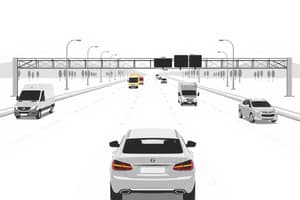Podcast
Questions and Answers
What are the three parts of the Highway Transportation System (HTS)?
What are the three parts of the Highway Transportation System (HTS)?
- People
- Vehicles
- Roadways
- All of the above (correct)
What does the IPED process stand for?
What does the IPED process stand for?
Identify, Predict, Decide, Execute
What does the Zone Control System manage?
What does the Zone Control System manage?
The space around your car
Low risk driving means actively monitoring other vehicles and roadway users.
Low risk driving means actively monitoring other vehicles and roadway users.
What is a collision?
What is a collision?
Which of the following are considered regulatory signs?
Which of the following are considered regulatory signs?
What do warning signs do?
What do warning signs do?
What do guide signs mark?
What do guide signs mark?
What is the purpose of traffic signals?
What is the purpose of traffic signals?
Flashing signals alert drivers to dangerous conditions.
Flashing signals alert drivers to dangerous conditions.
What is an HOV lane reserved for?
What is an HOV lane reserved for?
What is the purpose of a rumble strip?
What is the purpose of a rumble strip?
What does an odometer indicate?
What does an odometer indicate?
What does the term 'road rage' refer to?
What does the term 'road rage' refer to?
What is the definition of visual acuity?
What is the definition of visual acuity?
What does the term 'glare recovery time' refer to?
What does the term 'glare recovery time' refer to?
A moped is a small two-wheeled vehicle that can only be pedaled.
A moped is a small two-wheeled vehicle that can only be pedaled.
What is the meaning of the Zero Tolerance Law?
What is the meaning of the Zero Tolerance Law?
What are projectiles in driving context?
What are projectiles in driving context?
Gravity is the force that pulls vehicles toward the earth.
Gravity is the force that pulls vehicles toward the earth.
Match the following distractions to their definitions:
Match the following distractions to their definitions:
What does the term 'total stopping distance' refer to?
What does the term 'total stopping distance' refer to?
An uncontrolled intersection has signs or signals to regulate traffic.
An uncontrolled intersection has signs or signals to regulate traffic.
Flashcards are hidden until you start studying
Study Notes
Highway Transportation System (HTS)
- Consists of three components: people, vehicles, and roadways.
- Aims to safely, efficiently, and economically transport people and cargo.
IPED Process
- A four-step approach: identify, predict, decide, execute.
Zone Control System
- A system for managing the space around a vehicle to enhance safety.
Low Risk Driving
- Involves actively monitoring surrounding vehicles and roadway users.
Collision
- Occurs when a vehicle strikes another object.
Operating vs. Fixed Costs
- Operating costs include fuel, oil, and tires.
- Fixed costs encompass car price, licensing fees, and insurance.
Traffic Signs
- Regulatory Signs: Indicate laws like stop and yield.
- Warning Signs: Alert drivers to hazards and conditions.
- Guide Signs: Offer information about routes and services.
- International Signs: Utilize symbols instead of text.
Traffic Signals
- Keep traffic moving safely, with special signals like flashing alerts to indicate danger.
High Occupancy Vehicle (HOV) Lane
- Reserved for buses and carpools with 2 or more passengers.
Shared Left Turn Lane
- Center lane utilized by vehicles going in both directions for left turns.
Rumble Strip
- A textured road feature that warns drivers of nearby hazards.
Vehicle Controls
- Shift Lever: Used for changing gears.
- Cruise Control: Maintains a desired speed.
- Shift Indicator: Shows gear positions in automatic cars.
- Tachometer: Displays engine revolutions per minute.
- Odometer: Tracks total miles driven.
Safety Systems
- Anti-lock Braking System (ABS): Prevents wheel lock-up during hard braking.
- Key Fob: Wireless device for remote vehicle access.
Steering Wheel Position
- Recommended hand positions: 9-3 or 8-4.
Driving Reference Points
- Target: Aim for a specific point while driving.
- Braking Point: Location where brakes are applied to slow down.
Vision Types
- Visual Acuity: Clarity of vision.
- Field of Vision: Overall area visible while driving.
- Central Vision: Direct line of sight ahead.
- Peripheral Vision: Outside direct focus area.
- Fringe Vision: Closest peripheral vision to central vision.
- Tunnel Vision: Very narrow field of view (less than 140 degrees).
Alcohol and Driving
- Blood-Alcohol Concentration (BAC): Measurement of alcohol in the bloodstream.
- Zero Tolerance Law: Drivers under 21 with a BAC over 0.02 may face penalties.
- Dram Shop Law: Establishes liability for serving alcohol to intoxicated persons.
- Field Sobriety Test: Series of tests to check for driver impairment.
Distractions While Driving
- Driver Inattention: Focus drifting away from driving tasks.
- Various Types:
- Cognitive: Lost in thought.
- Visual: Eyes off the road.
- Auditory: Distracting sounds.
- Biochemical: Physical acts unrelated to driving.
Vehicle Dynamics
- Gravity: Pulls vehicles towards the earth.
- Friction and Traction: Essential for maintaining grip on the road.
- Blowout: Sudden tire air loss, often due to wear.
Stopping Distance Components
- Total Stopping Distance: Distance travelled during the stop.
- Perception, Reaction, and Braking Distances: Segments of stopping distance based on identification, response, and braking.
Traffic Control and Rights
- Controlled Intersection: Governed by traffic signals or signs.
- Right of Way: The privilege of using roadway space.
- Roundabout: Circular intersection for traffic flow.
Miscellaneous
- Moped: Small, two-wheeled vehicle with pedals or a motor.
- No Zone: Blind spots around large vehicles that limit visibility for their drivers.
Studying That Suits You
Use AI to generate personalized quizzes and flashcards to suit your learning preferences.




